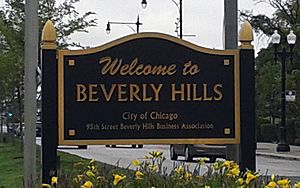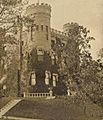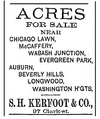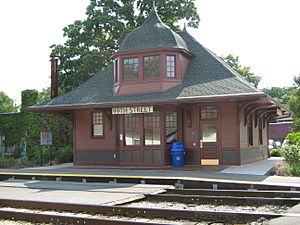Beverly, Chicago facts for kids
Quick facts for kids
Beverly
|
|
|---|---|
|
Community area
|
|
| Community Area 72 - Beverly Hills | |

Welcome sign at the corner of 95th Street and Western Avenue
|
|

Location within the city of Chicago
|
|
| Country | United States |
| State | Illinois |
| County | Cook |
| City | Chicago |
| Neighborhoods |
List
Beverly
East Beverly North Beverly West Beverly |
| Area | |
| • Total | 3.19 sq mi (8.3 km2) |
| Population
(2020)
|
|
| • Total | 20,027 |
| • Density | 6,278/sq mi (2,424/km2) |
| Demographics (2018) | |
| • White | 56.7% |
| • Black | 34.9% |
| • Hispanic | 5.4% |
| • Asian | 0.9% |
| • Other | 2.1% |
| Time zone | UTC-6 (CST) |
| • Summer (DST) | UTC-5 (CDT) |
| ZIP Codes |
parts of 60620, 60643, 60655
|
| Area Codes | 773, 872 |
| Median income | $98,416 |
Beverly, officially Beverly Hills, is the 72nd of Chicago's 77 community areas. Located 12 miles (19 km) from the Loop, it is on the city's far south side. Beverly is considered part of the Blue Island Ridge, along with the nearby community areas of Morgan Park and Mount Greenwood, and Washington Heights, and the City of Blue Island. As of 2018[update], Beverly had 20,437 inhabitants.
Sparsely settled until the late 19th century, Beverly was incorporated as part of the Village of Washington Heights in 1874 and began development by business interests from Chicago. The area was annexed by the city of Chicago in 1890 and continued to grow with the completion in the Rock Island Railroad that runs parallel along the eastern edge of the Blue Island ridge to its terminus at LaSalle Street Station in downtown Chicago. Beverly's situation along on the ridge allowed the community to become an exclusive streetcar community, which is reflected in the homes and large lots.
Contents
Access
Beverly has quick access (by public transport or car) to all of the Chicago financial markets, shopping, airports, and attractions, yet retains itself as a peaceful and quiet wooded community. Beverly is one of the top five largest historic districts in any major city in the USA. The particular trains that are accessed by the Beverly community are provided from Metra's Rock Island line.
North Blue Island
Beverly is one of few areas in the City of Chicago that features a hilly terrain. This geography is due to its location in the middle of the geological formation known as the Blue Island Ridge. In its early years of settlement this area as well as Morgan Park to the south was known as North Blue Island, denoting its relationship to the village of Blue Island, which was settled in 1836 and is located a few miles to the south.
Ethnicity
| Historical population | |||
|---|---|---|---|
| Census | Pop. | %± | |
| 1930 | 13,793 | — | |
| 1940 | 15,910 | 15.3% | |
| 1950 | 20,186 | 26.9% | |
| 1960 | 24,814 | 22.9% | |
| 1970 | 26,797 | 8.0% | |
| 1980 | 23,360 | −12.8% | |
| 1990 | 22,385 | −4.2% | |
| 2000 | 21,992 | −1.8% | |
| 2010 | 20,034 | −8.9% | |
The neighborhood's roots are largely English and Protestant but is now home to a large Irish-American/Catholic community and many Irish establishments. Prior to European American settlement the area was home to the Potawatomi Indians, who in 1833, after the Black Hawk War, were moved west of the Mississippi River by the federal government. The community (along with Morgan Park to the south) is the home of the South Side Irish Parade, which is held every year on the Sunday prior to St. Patrick's Day. It hails as the largest neighborhood parade of any type in the country.
The neighborhood currently is home to more Irish-style pubs than any other in Chicago. There is a house whose design was inspired by castles from the builder's native Ireland. The Beverly Branch Library has the largest Irish heritage collection in Chicago. This branch opened a new facility in June 2009 which has a new LEED certified design and engineering. Beverly Branch houses a bronze sculpture by Virginio Ferrari entitled Two Lovers; additional art has been commissioned for the new branch. Artwork was funded through the Percent for Art Ordinance administered by the City of Chicago Public Art Program.
During World War II, Beverly served as a peaceful sanctuary for wounded officers in the Allied Forced of many nations who were in recovery.
Gallery
-
Advertisement from the Chicago Daily Tribune, November 24, 1889, advertising lots for sale in Longwood, Beverly, and the surrounding region. The area at the northern end of the ridge was first known as "the long wood", and the name of Longwood as an area of Beverly and by extension the roadway Longwood Drive perpetuates this early history. The real estate firm of Samuel H. Kerfoot (1823-1896) claims the distinction of being the first business to re-open in the burnt district after the Great Fire of 1871
-
Beverly features the work of many notable architects, including Frank Lloyd Wright, George Washington Maher, Harry Waterman, Robert Seyfarth, Tallmadge and Watson and Walter Burley Griffin. This house at 10200 S. Longwood Drive was built in 1890 by Horace Horton, the owner of Chicago Bridge and Iron Company. It was designed by John G. Long, who was inspired by the H.A.C. Taylor house in Newport, Rhode Island by McKim, Mead & White (1886).
- Cullen, Maureen. "Boomerang Beverly." Chicago Sun-Times. July 13, 2007. S1 Front.
- Sherrod, Pamela. "12 months capture a neighborhood's history." Chicago Sun-Times. December 9, 2001. Home & Garden 3.
 |
Ashburn, Chicago | Auburn Gresham, Chicago |
|
||||
| Evergreen Park, Illinois | |||||||
| Washington Heights, Chicago | |||||||
| Mount Greenwood, Chicago | Morgan Park, Chicago |
Economy and employment
As of 2018[update], 66.7 percent of Beverly's population was in the labor force; the unemployment rate was 4.3 percent, compared to the citywide rate of 8.9 percent. Of those employed, a plurality (36.5 percent) worked outside Chicago; 32.9 percent worked in the Loop, 5.0 percent on the Near North Side, and 4.6 percent on the Near West Side. About 9.7 percent of those employed in Beverly lived there; nearly half lived outside Chicago.
Among Beverly residents, education was the leading employer, accounting for 19.1 percent of the population. The next two major industries of employment were health care (13.1 percent) and public administration (12.1 percent). Within the community area, professional employment, accommodation and food service, retail trade, and health care were the top four employer industries, accounting for 16.3, 15.7 14.1, and 11.8 percent, respectively.
Western Avenue and 95 Street are zoned for business, as well as the intersection of 99th Street and Longwood Drive (i.e. the area surrounding the 99th Street station) and the intersection of 103rd Street and Longwood Drive (i.e. the area surrounding the 103rd Street station).
Demographics
| Historical population | |||
|---|---|---|---|
| Census | Pop. | %± | |
| 1930 | 13,793 | — | |
| 1940 | 15,910 | 15.3% | |
| 1950 | 20,186 | 26.9% | |
| 1960 | 24,814 | 22.9% | |
| 1970 | 26,797 | 8.0% | |
| 1980 | 23,360 | −12.8% | |
| 1990 | 22,385 | −4.2% | |
| 2000 | 21,992 | −1.8% | |
| 2010 | 20,034 | −8.9% | |
| 2020 | 20,027 | 0.0% | |
| Source: | |||
Prior to European American settlement, the area was home to Potawatomi people, who in 1833, after the Black Hawk War, were forcibly moved west of the Mississippi River by the federal government. Beverly's early Caucasian settlement was largely English and Protestant, but by the early 20th century, a large influx of Irish Americans began to arrive in the neighborhood and the construction of several Roman Catholic church parishes and business establishments saw Beverly develop into a stronghold of the city's South Side Irish community.
In 2018[update], 20,437 people in 7,557 households lived in Beverly. This represents an increase of 2.0 percent from the 2010 U.S. Census, which in turn had represented a 8.9 percent decline from the 2000 U.S. Census. The area's racial composition was 56.7 percent white, 34.9 percent black, 0.9 percent Asian and 2.1 percent other racial categories. Hispanics or Latinos of any race made up 5.4 percent of the population. Along with being known for its Irish American community identity, Beverly is also known for being one of the most racially integrated neighborhoods in Chicago with one of the city's highest percentage of black residents among white-majority neighborhoods. The age range in 2018[update] was broad, with 25.2 percent under the age of 19, 13.8 percent aged 20 to 34, 20.3 percent aged 35 to 49, 24.4 percent aged 50 to 64, 10.3 percent aged 65 to 74, 4.2 percent 75 to 84, and 1.7 percent 85 and older. The median age was 43. English was the only language spoken by 93.5 percent of the population aged five and older, compared to a citywide figure of 64 percent.
The median household income was $98,416, compared to the citywide median income of $55,198. Eight percent of households earned less than $25,000 annually; 14.4 percent earned between $25,000 and $49,999; 13.2 percent earned between $50,000 and $74,999; 15.4 percent earned between $75,000 and $99,999; 17.2 percent earned between $100,000 and $149,999, and 31.9 percent earned more than $150,000. This compares with a citywide distribution of 25.4 percent, 20.5 percent, 15.6 percent, 11.0 percent, 13.2 percent and 14.3 percent respectively. As of September 2015[update], the western census tracts in the area had a median household income of over $86,900; the eastern tracts had a median household income between $57,900 and $86,900. The entire area placed above the U.S. Department of Housing and Urban Development's low-income limit.
The hardship index is a metric used by the City of Chicago which considers six indicators of public health to quantify the relative amount of hardship in a community area: the percentage of occupied housing units with more than one person per room; the percentage of households living below the federal poverty level; the percentage of persons in the labor force over the age of 16 years that are unemployed; the percentage of persons over the age of 25 years without a high school diploma; the percentage of the population under 18 or over 64 years of age; and per capita income. The index is represented as a score from 1 to 100, with a higher score indicating greater hardship. With data from 2006 to 2010[update], Beverly's hardship index was 12.
Education
In the Chicago Public Schools system, Beverly contains Elizabeth H. Sutherland, Alice L. Barnard, and Kate Starr Kellogg elementary schools. It is also home to Vanderpoel Magnet Elementary School. The community is home to three private Catholic elementary schools: St. Barnabas, St. John Fisher and Christ the King. In 2018[update] a plurality (28.1 percent) held a bachelor's degree. 28.0 percent held a graduate or professional degree, 18.3 percent had some college education without a degree, 13.3 percent held a high school diploma or equivalency, 8.7 percent held an associate's degree, and 3.7 percent had not completed high school. Respective citywide figures were 22.7, 15.6, 17.6, 22.9, 5.7, and 15.5 percent.
The Chicago Public Library opened a branch on 95th Street on June 8, 2009, featuring LEED certified design and engineering. It is home to the largest Irish heritage collection in Chicago. Artwork for the branch was funded through the Percent for Art Ordinance administered by the Chicago Public Art Program. They include a bronze sculpture entitled "Two Lovers" by Virginia Ferrari, a series of oil on canvas paintings entitled "Faces of Change" by Tim Anderson, five small and two large oil pieces on shaped birch entitled "Clerestory Suite" by Brian Ritchard, and two archival ink jet prints entitled "Imaginary Play" by Cecil McDonald Jr.
Transportation
Public transportation
Within Beverly, Metra operates five stations on the Rock Island District line, providing daily inbound commuter-rail service to LaSalle Street Station in Chicago and outbound service to the Joliet Transportation Center. The line stops approximately every four blocks in a distinct difference between other regions it services: the 91st Street station, 95th Street station, 99th Street station, 103rd Street station, and the 107th Street station. All stations are in Zone C for fare-collection purposes.
The 95th/Dan Ryan station on the Chicago Transit Authority (CTA)'s Red Line, the 14th busiest rapid-transit station on the Chicago "L" in June 2019[update], is in nearby Roseland. Local buses include the CTA 95, 103, and 112 routes with full-time service, and part-time service on the 9 CTA route and the 349 and 381 Pace routes.
Private transportation
As of 2018[update], a plurality of occupied housing units (41.9 percent) have two vehicles available; 37.4 percent of units have one vehicle available. Three or more vehicles are available in 16.8 percent of housing units; 3.9 percent of units have none. Most workers 16 years and older (70.2 percent) drive alone to work. The rest use other means of transportation; 20.8 percent take transit (compared to 23.5 percent citywide), 6.1 percent carpool, 2.0 percent walk or bicycle, and 0.9 percent use other modes. Highly-walkable areas account for over 95 percent of residents and jobs; the Chicago Metropolitan Agency for Planning defines such areas by population density, city-block length, tree-canopy cover, fatalities (or serious injuries) to pedestrians and bicyclists, density at intersections, and nearby amenities.
Notable residents
- Lance Ten Broeck (b. 1956), professional golfer. He was raised in Beverly.
- Mike Castle (b. 1989), actor best known for starring in the TBS television series Clipped. He was raised in Beverly.
- William Cunningham (b. 1967), member of the Illinois Senate since 2013. He is a Beverly resident.
- Count Dante (1939–1975), American martial artist. He was born and raised in Beverly.
- Richard Duchossois (born 1921), businessman and owner of Arlington Park. He was a childhood resident of Beverly.
- Henry K. Holsman (1866–1963), car manufacturer and founder of Holsman Automobile Company. He resided at 9332 South Damen Avenue.
- Michael Howlett (1914–1992), 33rd Secretary of State of Illinois. He resided at 9630 South Winchester Avenue during his political career.
- Daniel Hynes (b. 1968), 6th Illinois Comptroller. He served from 1999 until 2011. He was raised in the Beverly area.
- Thomas Hynes (1938–2019), 34th President of the Illinois Senate and longtime Cook County Assessor. He is the father of Daniel Hynes.
- John R. Lausch Jr. (b. 1970), U.S. Attorney for the Northern District of Illinois (2017–present)
- Richard H. Lawler (1895–1982), transplant pioneer. He was a Beverly resident.
- Vincent LoVerde (b. 1989), American Hockey League player. He was raised in Beverly and has played with Ontario Reign and the Manchester Monarchs.
- Morgan F. Murphy (1932–2016), Democratic member of the United States House of Representatives from 1971 to 1981, resided in Beverly.
- P. Scott Neville Jr., jurist and member of the Illinois Supreme Court.
- Matthew O'Shea (b. 1969), member of the Chicago City Council from the 19th ward. A lifelong Beverly resident, he has represented Beverly and the surrounding area on the City Council since 2011.
- Craig Robinson (b. 1971), actor and comedian, best known for the role of Darryl Philbin on the television show The Office. He was raised in North Beverly.
- Ethel Spears (1903–1974), American painter. She grew up in Beverly.
- John Paul Stevens (1920–2019), attorney and jurist who served as Associate Justice of the Supreme Court of the United States from 1975 to 2010. He resided at 9332 South Damen Avenue at the start of his legal career.
- Daniel Sunjata (b. 1971), actor. He was raised in the Beverly neighborhood.
- Marie H. Suthers (1895–1983), longtime member of the Chicago Board of Elections from 1952 to 1983 and a member of the Illinois House of Representatives from 1951 to 1953. She was a resident of Beverly.
- Duke Tumatoe (b. 1947), American blues musician and guitarist who was a member of REO Speedwagon and is best known for his independent career. He was raised in Beverly.
- James C. Tyree (1957–2011), chief executive officer of Mesirow Financial from 1994 until his death. He was raised in the Beverly area.
- Paul Vallas (b. 1953), superintendent of the post-Katrina, statewide Recovery School District in Louisiana. He lived in Beverly while serving as the Chief Executive Officer of the City of Chicago School District #299.
- Lana (b. 1965) and Lilly Wachowski (b. 1967) (known professionally as The Wachowskis), are film directors best known for The Matrix trilogy. The two sisters were raised in Beverly.
- D. Everett Waid (1864–1939), architect who designed, among others, the Metropolitan Life North Building and the Metropolitan Life Insurance Company Hall of Records. He designed, built, and resided at 9332 South Damen Avenue.
- George Wendt (b. 1948), actor and comedian, best known for the role of Norm Peterson in the television show Cheers. He was raised in Beverly.
- Jamila Woods (b. 1989), poet and musician, best known for collaborations with rap artist Chance the Rapper. She was raised in Beverly, and references this in her poem Ghazal for White Hen Pantry.
- Graham Elliot (b. 1977), American Chef who co-hosted the TV series Master Chef Jr. He has been nominated three times for the James Beard Award.
Images for kids







